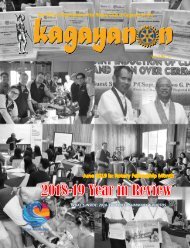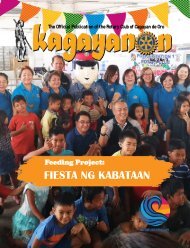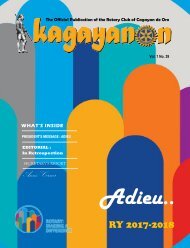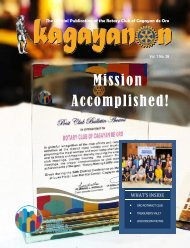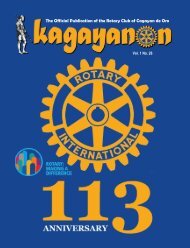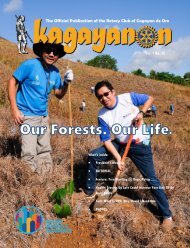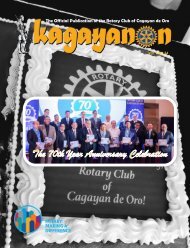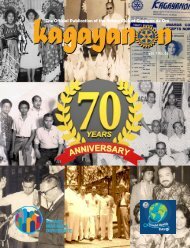RCCDO January25 Bulletin
The Official Publication of the Rotary Club of Cagayan de Oro
The Official Publication of the Rotary Club of Cagayan de Oro
You also want an ePaper? Increase the reach of your titles
YUMPU automatically turns print PDFs into web optimized ePapers that Google loves.
Vol. 1 No. 23<br />
JANUARY RI THEME: VOCATIONAL SERVICE MONTH<br />
2018-19 RI President<br />
Barry Rassin wants Rotary<br />
members to Be the Inspiration
OUR PAST PRESIDENTS<br />
1947-1948 Isidro Vamenta<br />
1948-1949 Isidro Vamenta<br />
1949-1950 Hernando Pineda<br />
1950-1951 Hernando Pineda<br />
1951-1952 Glicerio Floirendo<br />
1952-1953 Hernando Pineda<br />
1953-1954 Johnny Paraiso<br />
1954-1955 Ernesto Tamparong<br />
1955-1956 Nemesio Chaves<br />
1956-1957 Rizal Ortega<br />
1957-1958 Emilio Dayrit<br />
1958-1959 Wadhu Dharamdas<br />
1959-1960 Jesus Larrabaster<br />
1960-1961 Henry Canoy / Climaco Mosqueda<br />
1961-1962 Jesus Larrabaster<br />
1962-1963 Delfin Rabe<br />
1963-1964 Pablo Reyes<br />
1964-1965 Jose Palacio<br />
1965-1966 Briccio Tamparong<br />
1966-1967 Plutarico Velez<br />
1967-1968 Francisco Velez<br />
1968-1969 Dante Sarraga<br />
1969-1970 Miguel Siojo<br />
1970-1971 Rene Fruto<br />
1971-1972 Roberto Nery<br />
1972-1973 Angel Quimpo<br />
1973-1974 Perfecto Casino<br />
1974-1975 Mario Nery / Nestor Fernandez<br />
1975-1976 Casimiro Tamparong<br />
1976-1977 Phil Balan<br />
1977-1978 Benjamin Gorospe<br />
1978-1979 Antonio Valoria / Nazar Chavez<br />
1979-1980 Manuel Samson<br />
1980-1981 Nazar Chaves<br />
1981-1982 Corazon Cid<br />
1982-1983 Jesus Dingcong<br />
1983-1984 Miguel Goking<br />
1984-1985 Marciano Barrera<br />
1985-1986 Salvador Caragos<br />
1986-1987 Pablo Paras<br />
1987-1988 Leo Mabulay<br />
1988-1989 Manuel Aberilla<br />
1989-1990 Stephen Gaisano<br />
1990-1991 Primitivo Bella<br />
1991-1992 Cesilo Adaza<br />
1992-1993 Wenifredo Yancha<br />
1993-1994 Manuel Arceno/Constantino Jaraula<br />
1994-1995 Francisco Sarraga<br />
1995-1996 Constantino Jaraula<br />
1996-1997 Gabriel Evangelista<br />
1997-1998 Jose Gonzaga<br />
1998-1999 Carlos Gorospe<br />
1999-2000 William Walter<br />
2000-2001 Vic Cinco<br />
2001-2002 Raymund Talimo<br />
2002-2003 Carlo Romero<br />
2003-2004 Antonio Soriano<br />
2004-2005 Samson Blanco<br />
2005-2006 Manuel Alinabon<br />
2006-2007 John Mark Sarraga<br />
2007-2008 Edgardo Melchor Palad<br />
2008-2009 Ricardo Gabaon<br />
2009-2010 Manuel Along<br />
2010-2011 Dietmar Schug<br />
2011-2012 Ian Mark Nacaya<br />
2012-2013 Marillo Paano<br />
2013-2014 Ferdinand Bernasor<br />
2014-2015 Luigi Sarraga<br />
2015-2016 Cris Parojinog<br />
2016-2017 Dufel Lagrosas<br />
2
PROGRAM<br />
CALL TO ORDER<br />
INVOCATION<br />
PAMBANSANG AWIT<br />
FELLOWSHIP<br />
ENTERTAINMENT<br />
ROTARY INFORMATION<br />
SECRETARY’S REPORT<br />
PRESIDENT’S TIME<br />
ADJOURNMENT<br />
PROGRAM COORDINATOR<br />
PRES. TONYBOY FERNANDEZ<br />
RTN JUN SARMIENTO<br />
RTN NOEL DAJAO<br />
TREAS. ARIEL CENIZA<br />
PAG MANNY ALINABON<br />
DIR. GLENN DAEL<br />
TRF UPDATE<br />
SEC. NEIL QUE<br />
PRES. TONYBOY FERNANDEZ<br />
PRES. TONYBOY FERNANDEZ<br />
PP CALOY GOROSPE<br />
WHAT’S INSIDE:<br />
President's Message 5<br />
Secretary’s Report 6<br />
Meeting Photos 7<br />
Be the Inspiration 8-9<br />
5 ways to inspire through<br />
vocational service<br />
What Is Bitcoin 12-13<br />
How robot taxis will change mobility<br />
over the next 10 years<br />
11<br />
15-16<br />
Editorial Staff<br />
RTN MIKE MENDOZA<br />
Editor-In-Chief<br />
Contributors & Members<br />
Pres. Tonyboy Fernandez<br />
PAG John Mark Sarraga<br />
ANN Pres. Angelie Mae Dael<br />
Sec. Neil Que<br />
Dir Leony Quicoy<br />
PD Nasali Cornelio Silava<br />
RTN. Rey Lomarda<br />
Dir. Gus Rodano<br />
Did You Know 17<br />
e pray that this meeting is<br />
W successful, productive, and<br />
blessed. Holy Spirit guide us during our<br />
discussions. Give us wisdom concerning<br />
the issues that we face. Lord, we give<br />
You the glory for what we accomplish in<br />
Jesus name, Amen.<br />
3
4
President Tonyboy Fernandez<br />
F<br />
ellow Rotarians: There is always a<br />
first time. I broke my 100% attendance<br />
because of a simple<br />
application form which had to revised<br />
twice in a span of a few days due<br />
to printing errors which I never imagined<br />
would happen. But because of stringent<br />
rules , I had to just be patient and do it<br />
over again until it was correct. And since<br />
I was in Manila , I had to wait another<br />
day to submit it. Lesson Learned . As of<br />
this writing , I hope you are all convinced<br />
that the Starkey Hearing<br />
Aid project is a laudable one to accept.<br />
When I first heard about it from Dr.<br />
Nery of JRBMH, I immediately accepted<br />
the chance to hear about it in a meeting<br />
with JRBorja hospital and Starkey officials<br />
. I was never aware of the number<br />
of people who have an impairment to<br />
hearing and how much each hearing aid<br />
costs but after the briefing , PE Danny<br />
Empedrad , Dir Leony Quicoy and I<br />
agreed for our club to look into it as part<br />
of the program for RY 2018-2019. The<br />
Board has already approved the endeavour<br />
.What makes it more laudable is the<br />
number of targeted patients , 800 people.<br />
With this in mind , it is our hope<br />
that we will be able to help these 800<br />
have a better quality of life.<br />
This week, we will also be participating<br />
in RYLA. We will have 2 participants who<br />
we will send off to Malaybalay this coming<br />
Jan 26, 2018. The host for this year’s<br />
RYLA is the Rotary Club of Malaybalay. It<br />
is again our hope that these two individuals<br />
will be able to put good use their<br />
experiences gained in the Youth camp .<br />
We have already paid our annual dues<br />
for the RY 2017-2018. Treas. Ariel Ceniza<br />
informed me of this good news and<br />
this has also been reported to Rotary<br />
International . I am now waiting for the<br />
acknowledgment of RI which I hope to<br />
receive any time. For those who have<br />
not yet fully paid your dues , please do<br />
so as soon as possible. This will help<br />
augment our overhead expenses which<br />
is still quite big until June 2018. We do<br />
not want to have a deficit turnover to<br />
the next term.<br />
Again , I enjoin you to join us in helping<br />
out Rotary Foundation. We have a few<br />
more weeks to till the Recognition Night<br />
in the latter part of February. We need<br />
about $ 4,900 to meet our objective<br />
which we promised RI District Governor<br />
Linda Deleste. So Fellow Rotarians , lets<br />
do it! Thank you..<br />
5
Secretary Neil Ronard J. Que<br />
25<br />
Rotarians attended last week’s<br />
meeting as we were graced by<br />
guests Ms. Elaine Dimayuga (speaker)<br />
and Ms. Lovella Bastillada from Starky<br />
Hearing Foundation. PE Danny Empedrad<br />
also invited Colonel James Espinosa<br />
as the meeting focused on partnership<br />
between <strong>RCCDO</strong>, Starky Foundation,<br />
JR Borja Hospital and the PNP on<br />
what could potentially benefit over 800<br />
hearing deficient recipients by the end<br />
of 2018.<br />
JANUARY 2018 MILESTONES<br />
BIRTHDAYS (JAN. 22-31)<br />
24—PP PAUL FERRER<br />
29 –RTN JUN HIPONA<br />
31 –ANN AIDA GONZAGA<br />
WEDDING ANNIVERSARIES (JAN. 22-31)<br />
25–PVP HONG & GLORIA SEE<br />
Let us congratulate also<br />
WIWAG Chairman Rey<br />
Lomarda for a successful<br />
partnership with La Salle<br />
Academy, Iligan City for the<br />
WIWAG Program with their<br />
Grade 12 ABM students on<br />
December 4-7, 2017.<br />
Through his efforts, Chairman<br />
Rey was awarded a<br />
Certificate of Appreciation<br />
by La Salle on behalf of<br />
<strong>RCCDO</strong>. Great Job Chairman<br />
Rey!<br />
6
PHOTO<br />
7
STRAIGHT FROM THE TOP: ROTARY.ORG<br />
Source: Rotary.org<br />
R<br />
otary International Presidentelect<br />
Barry Rassin laid out his<br />
vision for the future of the organization<br />
on Sunday, calling on leaders<br />
to work for a sustainable future and to<br />
inspire Rotarians and the community at<br />
large.<br />
Rassin, a member of the Rotary Club of<br />
East Nassau, New Providence, Bahamas,<br />
unveiled the 2018-19 presidential<br />
theme, Be the Inspiration, to incoming<br />
district governors at Rotary’s International<br />
Assembly in San Diego, California,<br />
USA. “I want you to inspire in your clubs,<br />
your Rotarians, that desire for something<br />
greater. The drive to do more, to be<br />
more, to create something that will live<br />
beyond each of us.”<br />
Rassin stressed the power of Rotary’s<br />
new vision statement, “Together, we see<br />
a world where people unite and take<br />
action to create lasting change — across<br />
the globe, in our communities, and in<br />
ourselves.” This describes the Rotary<br />
that leaders must help build, he said.<br />
To achieve this vision, the presidentelect<br />
said, Rotarians must take care of<br />
the organization: “We are a membership<br />
organization first. And if we want to be<br />
able to serve, if we want to succeed in<br />
our goals — we have to take care of our<br />
members first.”<br />
Rassin asked the incoming district governors<br />
to “inspire the club presidents, and<br />
the Rotarians in your districts, to want to<br />
change. To want to do more. To want to<br />
reach their own potential. It’s your job to<br />
motivate them — and help them find<br />
their own way forward.”<br />
8
Progress on polio<br />
Rassin noted that one source of inspiration<br />
has been Rotary’s work to eradicate<br />
polio. He described the incredible progress<br />
made over the past three decades.<br />
In 1988, an estimated 350,000 people<br />
were paralyzed by the wild poliovirus;<br />
just 20 cases were reported in 2017 as<br />
of 27 December. “We are at an incredibly<br />
exciting time for polio eradication,”<br />
he said, “a point at which each new case<br />
of polio could very well be the last.”<br />
He emphasized that even when that last<br />
case of polio is recorded, the work won’t<br />
be finished. “Polio won’t be over, until<br />
the certifying commission says it’s<br />
over—when not one poliovirus has been<br />
found, in a river, in a sewer, or in a paralyzed<br />
child, for at least three years,” he<br />
said. “Until then, we have to keep doing<br />
everything we’re doing now.” He urged<br />
continued dedication to immunization<br />
and disease surveillance programs.<br />
Sustaining the environment<br />
Rotary has focused heavily on sustainability<br />
in its humanitarian work in recent<br />
years. Now, Rassin said, Rotarians must<br />
acknowledge some hard realities about<br />
pollution, environmental degradation,<br />
and climate change. He noted that 80<br />
percent of his own country is within one<br />
meter of sea level. With sea levels projected<br />
to rise two meters by 2100, he<br />
said, “my country is going to be gone in<br />
50 years, along with most of the islands<br />
in the Caribbean and coastal cities and<br />
low-lying areas all over the world.”<br />
their communities. “We want the good<br />
we do to last. We want to make the<br />
world a better place. Not just here, not<br />
just for us, but everywhere, for everyone,<br />
for generations.”<br />
Barry Rassin, of the Rotary Club of<br />
East Nassau, New Providence, Bahamas,<br />
has earned an MBA in health and hospital<br />
administration from the University of<br />
Florida and is the first fellow of the<br />
American College of Healthcare Executives<br />
in the Bahamas. He recently retired<br />
after 37 years as president of Doctors<br />
Hospital Health System, where he continues<br />
to serve as an adviser. He is a<br />
lifetime member of the American Hospital<br />
Association and has served on several<br />
boards, including the Quality Council of<br />
the Bahamas, Health Education Council,<br />
and Employer’s Confederation.<br />
A Rotarian since 1980, Rassin has served<br />
Rotary as director and is vice chair of<br />
The Rotary Foundation Board of Trustees.<br />
He was an RI training leader and<br />
the aide to 2015-16 RI President K.R.<br />
Ravindran.<br />
Rassin received Rotary's highest honor,<br />
the Service Above Self Award, as well as<br />
other humanitarian awards for his work<br />
leading Rotary’s relief efforts in Haiti after<br />
the 2010 earthquake there. He and<br />
his wife, Esther, are Major Donors and<br />
Benefactors of The Rotary Foundation.<br />
Rassin’s nomination follows Sam F.<br />
Owori’s death in July 2017, just two<br />
weeks into his term as Rotary International<br />
president-elect.<br />
Rassin urged leaders to look at all of<br />
Rotary’s service as part of a larger global<br />
system. He said that this means the incoming<br />
district governors must be an<br />
inspiration not only to clubs, but also to<br />
9
10
5 ways to inspire<br />
through<br />
vocational<br />
service<br />
By Rotary Service and Engagement Staff<br />
V<br />
ocational Service calls on us to<br />
empower others by using our<br />
unique skills and expertise to<br />
address community needs and help others<br />
discover new professional opportunities<br />
and interests. January is Rotary’s<br />
Vocational Service Month, a great time<br />
to leverage vocational service in your<br />
club projects and activities.<br />
Here are five ways you can incorporate<br />
vocational service in your club activities:<br />
Host a club meeting at your work place<br />
and share about your profession; take<br />
time to learn about fellow members’<br />
occupations.<br />
Use your skills and expertise to serve a<br />
community.<br />
Practice your profession with integrity,<br />
and inspire others to behave ethically<br />
through your words and actions.<br />
Work with local businesses to create<br />
mentorship, internship, or practicum<br />
opportunities to help young people<br />
achieve their career goals.<br />
Guide and encourage others in their<br />
professional development.<br />
11<br />
Below are some examples of clubs taking<br />
action around the world:<br />
Members from the Rotary Club of<br />
Melbourne Park in Australia come<br />
from a variety of vocational backgrounds.<br />
Not only do they utilize their<br />
skills within the club, but they also have<br />
something to offer to a wider audience.<br />
They started the ‘Rotary Skillshare’ series<br />
with their Past President Jason<br />
Reynolds, who owns a financial advisory<br />
business and offered to conduct a series<br />
of presentations designed to help club<br />
members make smart choices when<br />
confronted with financial decisions. The<br />
club hopes to continue the series, highlighting<br />
a different club member’s profession<br />
to learn from their expertise.<br />
The Rotary Club of Kakuri-<br />
Kaduna in Nigeria organized a career<br />
guidance and entrepreneur workshop<br />
for students from their local secondary<br />
school. Students were surveyed beforehand<br />
for insight on their future career<br />
goals. Various speakers from different<br />
walks of life met with students to discuss<br />
their future plans.<br />
The Front Royal Rotary Club in the<br />
United States partners with the local<br />
Chamber of Commerce to put together<br />
an ethics workshop for high school seniors<br />
in which they are presented seven<br />
ethical dilemmas and have to determine<br />
the best route to solve each of issue.<br />
The Rotary Club of Bangalore Vijayanagar<br />
in India started a vocational<br />
training center offering computer training<br />
and tailored classes to help low income<br />
and unemployed men and women<br />
gain skills to become independent and<br />
self-sufficient.
By: SUE MARQUETTE POREMBA<br />
Y<br />
ou've probably heard a lot about<br />
Bitcoin lately. The digital currency's<br />
price rose astronomically in<br />
2017, going from less than $1,000 in<br />
March to a peak of more than $19,000<br />
in mid-December. Other so-called<br />
"cryptocurrencies" based on Bitcoin have<br />
had similarly shaped trajectories.<br />
What is Bitcoin?<br />
Bitcoin is a decentralized, digital-only<br />
currency. It has no central monetary<br />
authority. Instead, a peer-to-peer computer<br />
network keeps track of Bitcoin<br />
transactions and creates additional<br />
bitcoins through a process called<br />
"mining."<br />
Bitcoin users and their transactions are<br />
pseudonymous; there are no international<br />
exchange rates to figure out, and<br />
there's no need for middlemen to collect<br />
fees.<br />
Bitcoin was created in 2009, in the wake<br />
of the near-collapse of the global financial<br />
establishment and soon after an individual<br />
or group using the name<br />
"Satoshi Nakamoto" posted a paper<br />
online discussing the idea of a decentralized<br />
digital currency free from interference<br />
by governments and financial institutions.<br />
Nakamoto created the online<br />
bookkeeping system to record and track<br />
Bitcoin transactions and mined the first<br />
bitcoins.<br />
The software to create, track, hold and<br />
exchange bitcoins is open-source, so it<br />
can be used for free.<br />
What is the Bitcoin exchange rate?<br />
When Bitcoin was first released in 2009,<br />
one bitcoin wasn't worth much. A single<br />
U.S. dollar could buy more than 1,300<br />
bitcoins. As Bitcoin became more popular<br />
internationally, speculation caused<br />
the value of a single bitcoin to soar to<br />
$260 in early April 2013.<br />
Several cyberattacks caused the value to<br />
plummet to about $50 later that month<br />
in a wave of panic selling. But in November<br />
2013, the rate skyrocketed to about<br />
$1,200 due to Chinese speculation. At<br />
that point, the Chinese central bank took<br />
steps to prevent domestic trading in<br />
Bitcoin.<br />
For most of 2015, Bitcoin traded be-<br />
12
tween $200 and $400, but in mid-2016,<br />
the exchange rate began to move again,<br />
increasing rapidly over the following 18<br />
months to peak at about $19,000 in mid<br />
-December 2017.<br />
As of this writing, in January 2018, one<br />
bitcoin is worth about $10,000, quite a<br />
change from a few years ago and following<br />
a volatile ride in the previous few<br />
months. Its fluctuations are due, in part,<br />
to its capped amount of 21 million individual<br />
bitcoins and to its perceived value<br />
on the market.<br />
How do you buy bitcoins?<br />
Anyone can buy bitcoins. You'll first<br />
need to set up a Bitcoin wallet, either on<br />
a computer you control or with an online<br />
Bitcoin service. Some of the most popular<br />
services are Coinbase (perhaps the<br />
best wallet for beginners), Mycelium and<br />
Electrum. You can also find Bitcoin wallet<br />
apps in the iTunes App Store or<br />
Google Play. Most of these services will<br />
walk you through the process of setting<br />
up your wallet.<br />
Then you'll work through a broker to<br />
buy Bitcoin. Coinbase, again, is a good<br />
starting point for beginners, but other<br />
brokers include CEX, GDAX and Poloniex.<br />
You then use a credit card, debit<br />
card or bank transfer to make the purchase.<br />
What is Bitcoin mining?<br />
Bitcoins can be purchased using real<br />
money, but they can also be generated<br />
or "mined." Users generate bitcoins by<br />
having their computers solve difficult<br />
mathematical algorithms that help verify<br />
the creation of new bitcoins in the blockchain<br />
— the encrypted ledger that records<br />
and registers all Bitcoin activity —<br />
and the transfer of bitcoins between users.<br />
The algorithms become progressively<br />
more difficult over time.<br />
The total number of bitcoins that can<br />
ever be mined is 21 million. The cap prevents<br />
anyone from flooding the market<br />
and devaluing the bitcoins already in<br />
circulation. According to Blockchain.info,<br />
which provides real-time updates on<br />
bitcoins, at the beginning of 2018, there<br />
were just shy of 17 billion bitcoins in<br />
existence, or about 80 percent of the<br />
total number possible. The projected<br />
date by which all 21 million bitcoins will<br />
have been mined is 2040.<br />
What can you buy with Bitcoin?<br />
Because of the built-in pseudonymity,<br />
bitcoins are often used for illicit activity.<br />
However, many legitimate businesses,<br />
ranging from hotels to electronic stores,<br />
accept bitcoins. Here is a partial list of<br />
companies that accept Bitcoin as payment<br />
as of January 2018:<br />
Dish Network<br />
Expedia<br />
Golden Gate Hotel & Casino (Las Vegas)<br />
Microsoft<br />
Newegg<br />
OkCupid<br />
Overstock<br />
Reeds Jewelers<br />
Reddit<br />
Roadway Moving Company<br />
Subway<br />
Zynga<br />
There is also speculation that Amazon<br />
may soon accept Bitcoin, but that's only<br />
a rumor for now.<br />
About the Author: SUE MARQUETTE POREMBA<br />
Sue Marquette Poremba is a security and technology<br />
writer based in Central Pennsylvania.<br />
13
14
How robot taxis will change mobility<br />
over the next 10 years<br />
Source: https://www.weforum.org/<br />
A<br />
silent revolution is arriving on<br />
our streets. Before too long, commuters<br />
will use their mobiles to<br />
summon fully autonomous robot taxis.<br />
These will collect them from home and<br />
drive them to the closest metro station,<br />
from where they can catch a train to<br />
work in the city centre. These zeroemission<br />
vehicles will be electric, powered<br />
by solar or wind generation. We<br />
believe this transformation is just around<br />
the corner. It promises to change the<br />
mobility market, and much more.<br />
Within the next five years, cities will<br />
begin to transform their transit systems,<br />
to tackle the twin challenges of congestion<br />
and climate change. By using autonomous<br />
taxis with significantly higher capacity<br />
and usage rates, and integrated<br />
with traffic optimization systems, cities<br />
could reduce the number of cars on their<br />
streets by more than 40%.<br />
In an optimistic scenario, a city like Berlin<br />
could use robot taxis to carry up to<br />
60% of its passengers. Changes like this<br />
would bring clean, affordable and secure<br />
mobility to city residents.<br />
A more likely scenario sees autonomous<br />
vehicles making up 2% of new vehicle<br />
sales globally by 2025, rising to 8% by<br />
2030. If the cost of self-driving cars falls<br />
15<br />
faster, and cities introduce new mobility<br />
systems more quickly, autonomous vehicles<br />
could make up 30% or more of<br />
the market by 2030.<br />
Policies and investment<br />
Legislation will be a critical enabler in<br />
this transformation, as cities and countries<br />
make strong commitments to reduce<br />
carbon emissions. Regulations will<br />
increase pressure on internal combustion<br />
engine (ICE) vehicles, creating incentives<br />
for zero-emission cars such as<br />
battery-powered electric vehicles (EVs).<br />
Some cities will ban ICEs from their<br />
most congested districts, and could restrict<br />
these areas to shared vehicles.<br />
These regulatory changes will pave the<br />
way for greater use of electric, autonomous<br />
taxis.<br />
At the same time, automotive and technology<br />
companies are investing substantially<br />
in the software and hardware<br />
required for full automation of urban<br />
mobility (levels 4 and 5 of the Society of<br />
Automotive Engineers’ scale). Some<br />
companies are already piloting autonomous<br />
vehicles in cooperative cities.<br />
Waymo, a subsidiary of Alphabet, has<br />
logged four million self-driven miles.<br />
General Motors is also embracing the
opportunity. It forecasts a substantial<br />
increase of revenue generated for GM<br />
over a car’s lifetime. Daimler’s acquisition<br />
of mytaxi, an app-based mobility<br />
company, underscores the importance<br />
of platforms in this new ecosystem.<br />
Consumer behaviour is also evolving, as<br />
younger people show less appetite to<br />
own and drive cars. Car ownership has<br />
fallen since 2000 in some countries. Urbanization<br />
is also an important factor, as<br />
commuters seek alternative and integrated<br />
means of transportation. This<br />
further favours the emergence of robot<br />
taxis.<br />
Car manufacturers are preparing for this<br />
transformation. They recognize that it<br />
will shift some of the profit pool from<br />
manufacturing to technologies and services,<br />
including batteries, mobility services,<br />
and software that drives cars and<br />
manages mobility networks. As they<br />
expand their businesses to become mobility<br />
service providers, car companies<br />
will manage and maintain large fleets of<br />
robot taxis.<br />
Electricity suppliers will see fleets of electric<br />
vehicles as another decentralized and<br />
digitalized energy resource, capable of<br />
providing flexible power that can flatten<br />
demand peaks and reduce infrastructure<br />
investments. These companies will also<br />
play an important role in supplying ultrafast<br />
charging stations and managing the<br />
energy of buildings and microgrids connected<br />
to EV fleets.<br />
Finally, technology companies such as<br />
Uber, Lyft and Didi have accepted heavy<br />
losses to position themselves at the front<br />
of mobility services, as either platform<br />
owners or robot taxi fleet operators.<br />
They will continue to compete to gain<br />
market share.<br />
16
HONORARY MEMBERSHIP<br />
“H<br />
onorary” is one of the two types<br />
of membership a person may<br />
have in a Rotary Club. This type of membership<br />
is the highest distinction a Rotary<br />
Club can confer and is exercised only<br />
in exceptional cases to recognize an individual<br />
for unusual service and contributions<br />
to Rotary and society. Honorary<br />
members cannot propose new members<br />
to the club, do not hold office and are<br />
exempt from attendance requirements<br />
and club dues. Many distinguished heads<br />
of state, explorers, authors, musicians,<br />
astronauts and other public personalities<br />
have been honorary members of Rotary<br />
Clubs, including King Gustaf of Sweden,<br />
King George VI of England, King Badouin<br />
of Belgium, King Hassan III of Morocco,<br />
Sir Winston Churchill, humanitarian Albert<br />
Schweitzer, Charles Lindbergh, composer<br />
Jean Sibelius, explorer Sir Edmund<br />
Hillary, Thor Heyerdahl, Thomas Edison,<br />
Walt Disney, Bob Hope, Dr. Albert Sabin,<br />
British Prime Minister Margaret Thatcher<br />
and many of the presidents of the United<br />
States. Truly, those selected for honorary<br />
membership are those who have<br />
done much to further the ideals of Rotary.<br />
PAST SERVICE MEMBERSHIP<br />
A past service member is a retired person<br />
who is not yet qualified for senior<br />
active membership. One way a person<br />
can become a past service member is<br />
by being an active member and retiring<br />
from his or her business or profession.<br />
The Rotary club may also elect to past<br />
service membership a retired executive<br />
or professional who would have qualified<br />
for active membership when employed.<br />
In the latter case, there is no<br />
former classification associated with<br />
the individual. Despite a common misperception,<br />
a senior active member can<br />
never become a past service member.<br />
RULE OF 85<br />
The so-called “Rule of 85” is alive and<br />
well, although modified by the 2010<br />
Council on Legislation. It is hard to find<br />
because it is not officially called the<br />
“Rule of 85”, nor a type of Rotary<br />
membership (“Active” or “Honorary”<br />
are the only two) – it is merely a provision<br />
listed under “excused absences” in<br />
the Standard Rotary Club Constitution.<br />
It provides that if a members combined<br />
age and years of service equal 85 years<br />
or greater, they are at least age 65,<br />
and they ask to be excused, then they<br />
are excused. Additionally, they don’t<br />
count against the club’s attendance<br />
figures.<br />
Example: Member John Doe will be 65<br />
in June 2015 and he will have 20 years<br />
of service in October 2015. This qualifies<br />
him for exclusion from attendance<br />
starting in October 2015. This will not<br />
affect his or her membership status in<br />
any way, but will simply allow the Club<br />
Attendance Secretary to exclude him<br />
from the attendance percent if he does<br />
not make a meeting. However, if he<br />
attends a meeting he should be counted<br />
toward your overall percentage.<br />
17
NOTES<br />
18
19
20





